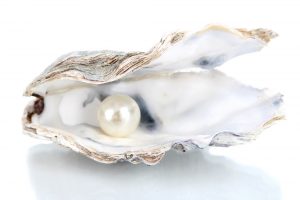The allure of pearls, with their iridescent beauty and timeless elegance, has captivated humanity for centuries. Behind each gleaming orb lies a fascinating tale of meticulous craftsmanship and nature’s unhurried pace. Understanding the intricate process of pearl formation sheds light on the extraordinary journey that these precious gems undertake before adorning our jewelry and adorning our lives.

Image: howgem.com
From Irritant to Adornment: The Curious Origins of Pearls
Unlike many gemstones formed deep within the Earth, pearls are organic creations born from the depths of living creatures. Their genesis begins with an irritant, often a tiny grain of sand or parasitic worm. When this foreign object finds its way into an oyster, mussel, or other pearl-bearing mollusk, a remarkable self-defense mechanism takes hold.
In an effort to protect its delicate tissues, the mollusk secretes layers of a substance called nacre, the same iridescent material found in its inner shell. Layer by layer, the layers accumulate around the irritant, gradually enveloping it in a pearl sac. As the nacre thickens, the irritant becomes less noticeable, until only the shimmering pearl remains.
The Pace of Nature: Time as the Essence of Pearl Creation
The formation of a pearl is a testament to nature’s unhurried artistry. Unlike diamonds, which crystallize under extreme heat and pressure over millions of years, pearls are the result of a gradual, year-by-year accumulation of nacre. The speed of pearl growth varies depending on the species of mollusk and environmental conditions, but on average, it takes a minimum of three years for a pearl to reach its mature size.
Some pearls, known as natural pearls, are formed spontaneously in the wild. However, the vast majority of pearls we encounter today are cultured pearls. Through a delicate process of human intervention, skilled cultivators introduce an irritant into the mollusk, initiating the pearl formation process. This method allows for greater control over the shape, size, and color of the pearl.
Factors That Shape the Pearl’s Destiny
While the process of pearl formation remains essentially the same, a myriad of factors can influence the characteristics of the resulting pearl. The type of mollusk, the surrounding water temperature, salinity levels, and diet all play a role in determining the pearl’s shape, size, luster, and color.
Oysters, for instance, are known to produce round or baroque pearls, while mussels often create elongated or drop-shaped pearls. The water temperature can affect the rate of pearl growth, while salinity levels influence the formation of different types of nacre. Diet, primarily the availability of planktonic food, provides the nutrients necessary for the mollusk to secrete abundant nacre.

Image: ubicaciondepersonas.cdmx.gob.mx
A Sustainable Art: Cultivating Pearls in Harmony with Nature
Modern pearl culturing practices have revolutionized the industry, ensuring a sustainable supply of these precious gems. By carefully managing pearl farms and minimizing environmental impact, cultivators strive to preserve the delicate ecosystems that support pearl-bearing mollusks.
This approach recognizes that the patience of nature is essential to the creation of pearls. By providing optimal conditions for the mollusks and respecting their natural rhythms, pearl cultivators ensure the continuation of this timeless art form for generations to come.
How Long To Make A Pearl
https://youtube.com/watch?v=ed8J33z_2FE
Conclusion
The creation of a pearl is a testament to the enduring beauty born from patience and perseverance. From the moment an irritant enters a mollusk to the shimmering orb that emerges years later, the journey of a pearl is an ode to nature’s intricate craftsmanship. Understanding the time and care invested in each pearl deepens our appreciation for these treasured adornments and the sustainable practices that preserve their timeless allure. As we marvel at the luster and elegance of pearls, let us also honor the unhurried artistry that brought them into existence.







